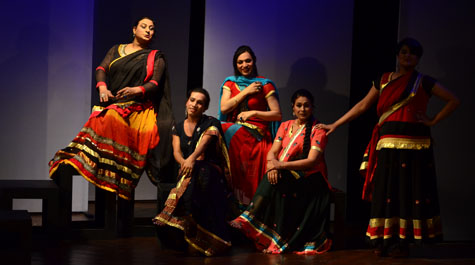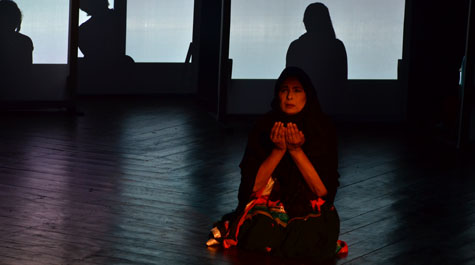Theatre professor explores struggles of Pakistani transgender communities in play
Claire Pamment, assistant professor of world theatre at William & Mary, believes theatre can change lives. “It’ cliché but I really do believe that it can,” she said. “It has the power to open up people’s hearts, minds and bodies to new ways of thinking, feeling and being in the world.”
That is precisely the reason Pamment created “Teesri Dhun (The Third Tune),” a documentary theatre production which celebrates the lives, struggles and culture of contemporary Pakistani transgender — or trans* — individuals, also known as hijras or khwajasaras. The play, which is the culmination of Pamment’s years of research on the subject and was co-directed with Iram Sana, founder of Pakistan’s Olomopolo Media, was devised with hijra and trans* actors, many of whom contributed personal narratives to the production. Pamment will deliver a presentation and discussion of the performance as part of the Global Film Festival on Friday, Feb. 24 at noon in Swem Library’s Reeder Media Center.
{{youtube:medium|P7MN7Btsrkc, Pamment and The Third Tune}}
“Research papers often take months to publish and then often don’t reach the people who need to hear the information most,” said Pamment. “Performance reaches a larger public community. For marginalized Pakistani trans* individuals who struggle against a rigid gender binary, performance is a formidable site of resistance, enabling them to express their ‘female souls’, and speak back to a regimented gender binary.”
Path to Pakistan
Pamment, whose international upbringing brought her from England to Fiji, first landed in Pakistan in 2003 through a one-week program that aimed to connect Muslim and non-Muslim individuals in theatre and encourage future collaborations. She was eager for a new understanding of performance that challenged the representations of South Asian theatre she had experienced on the British stage.
“I had just finished my master’s degree and was working with South Asian theatre communities in London at a time when multiculturalism was sort of embraced, but I felt we were producing rather stilted stereotypical representations of South Asian Muslim communities and playing to a primarily white middle class audience,” said Pamment.
In Pakistan, Pamment discovered rich repertoires of theatre and performance, from a range of marginalized groups, including the male comic duos known as bhands in the Punjab wielding their slapsticks against forces of class oppression and political chaos, to hijra communities with a longstanding tradition of performance that bristled against the gender binary and sexual norms, she said. Widely discriminated against both socially and politically, these communities became a focus of Pamment’s work in Pakistan, ultimately leading to the creation of a documentary theatre production called “Teesri Dhun (The Third Tune).”
A storied history
Told through song, dance and narrative, Teesri Dhun explores the contemporary challenges of hijra and trans* individuals in a 90-minute dramatic enactment. The play debuted in Lahore, Pakistan, in 2015, has been shown in the U.S. at Yale University and the University of Texas at Austin and was revived in Lahore in December 2016.
“A repeated narrative I heard while interviewing members of the hijra community is that their struggles really begin the first time they’re caught dressing up in their mother’s clothes or the first time they’re caught dancing,” said Pamment. “The antagonism is usually from the father or the brother, but those forces usually put the mother in this compromising role. That’s often the point of departure from the house for a hijra individual.”
In a heartfelt moment of the play, one of the performers tells the real-life story of the first time her mother allowed her to use her closet to dress as a woman, under the condition that she would dress as a male to a family wedding. As the actress finishes getting ready, she realizes that her mother is no longer there.
“She screams out to the audience ‘Ama, where are you?’” said Pamment. “But any of us could be her mother … she’s putting the responsibility back to us. She could be any of our children.”
Trans* children often leave their paternal families and join hijra communities, where elder hijra gurus take on the roles of mothers and teachers, said Pamment. Often denied formal education, hijras typically earn wages through begging, prostitution or performance.
“The hijra community occupies a hypervisible presence through badhai, which are the blessings at births, weddings and other occasions for celebration,” said Pamment. “These are ritualistic performances involving a group of hijras going to somebody’s house, sometimes with a group of musicians, clapping, dancing, joking and singing devotional Islamic poetry. Their performances, while marginalized, exemplify modes of social and religious acceptance.”
These performances participate in long genealogies of gender fluidity in South Asian Muslim culture, said Pamment. Khwajasaras once staffed not just harems at court but also key political roles. Devotional Sufi poetry often depicts the male devotee in feminine terms seeking re-union with her lover, God. It wasn’t until the mid-1800s — when India came under British colonial rule — that hijras became viewed as abnormal and targeted as criminals.
The road ahead
Though the stigma is still a force to contend with, hijras experienced a minor victory in 2009 when the Pakistani Supreme Court officially recognized the group as a third gender. Thanks mostly to NGOs, more opportunities are now available to hijra individuals — though Pamment notes there’s still a long way to go.
“In what has been described as the ‘transgender tipping point’ and much foreign policy hanging on issues of Muslim sexualities, there has been an exponential increase in foreign funded NGO initiatives concerning these communities. While this is bringing hijras into the purview of the elite and opening a dialogue transnationally, it is also important to recognize those pockets of acceptance that have kept hijra culture alive over the centuries and to grow from there,” said Pamment.
“I hope ‘Teesri Dhun’ contributes to this struggle by importantly celebrating the power of performance to negotiate spaces beyond the gender binary.”
Pamment's research with the hijra/trans* community is ongoing. In the fall, Indian hijra/trans* activist/author/performer Laxmi Narayan Tripathi will come to W&M as part of the COLL 300 IN/EXclusion theme to share her experiences of battling for hijra rights, from legislation to recognize a third gender identity in India's Supreme Court to performances and street activism with hijra sex workers.

















